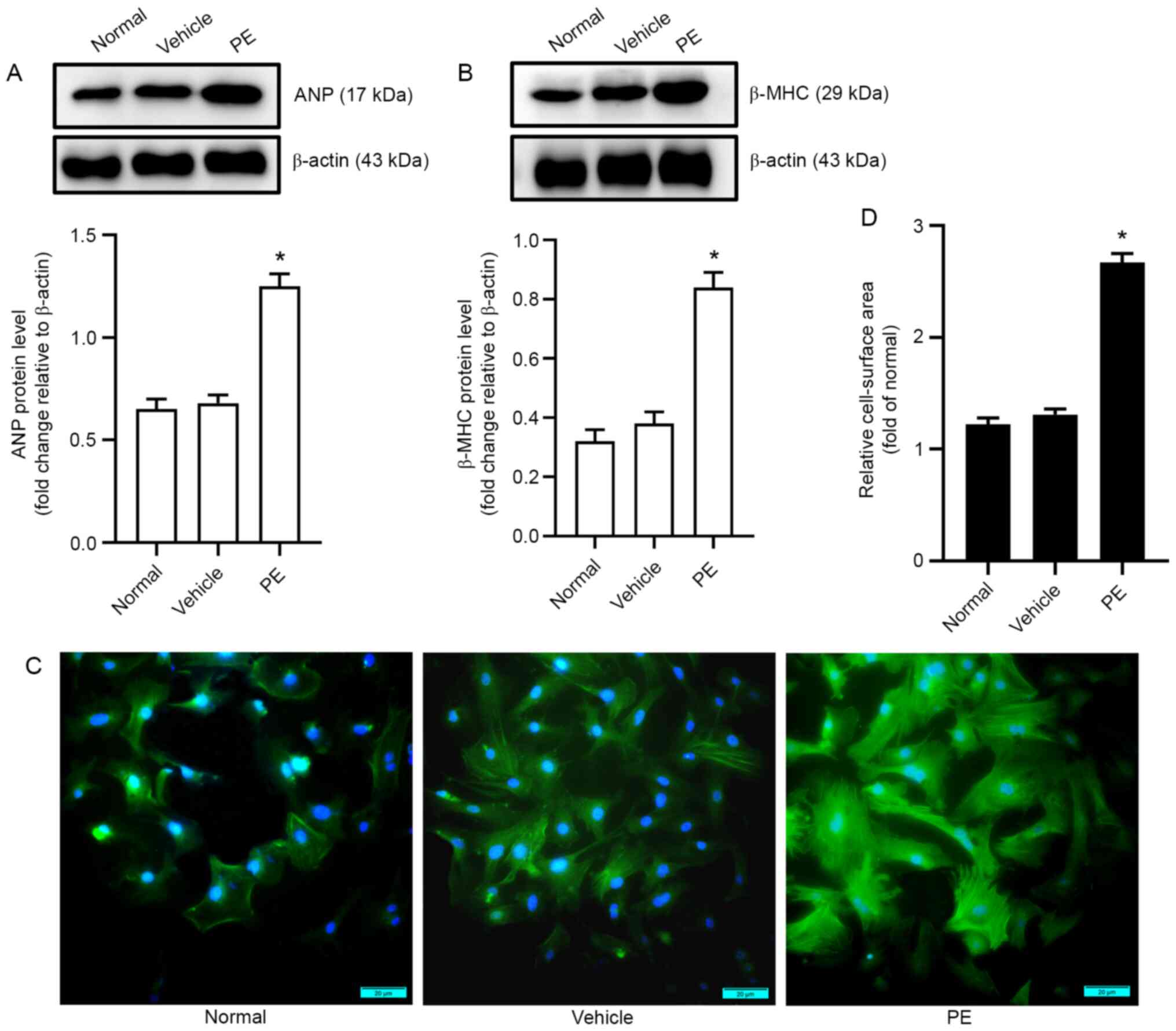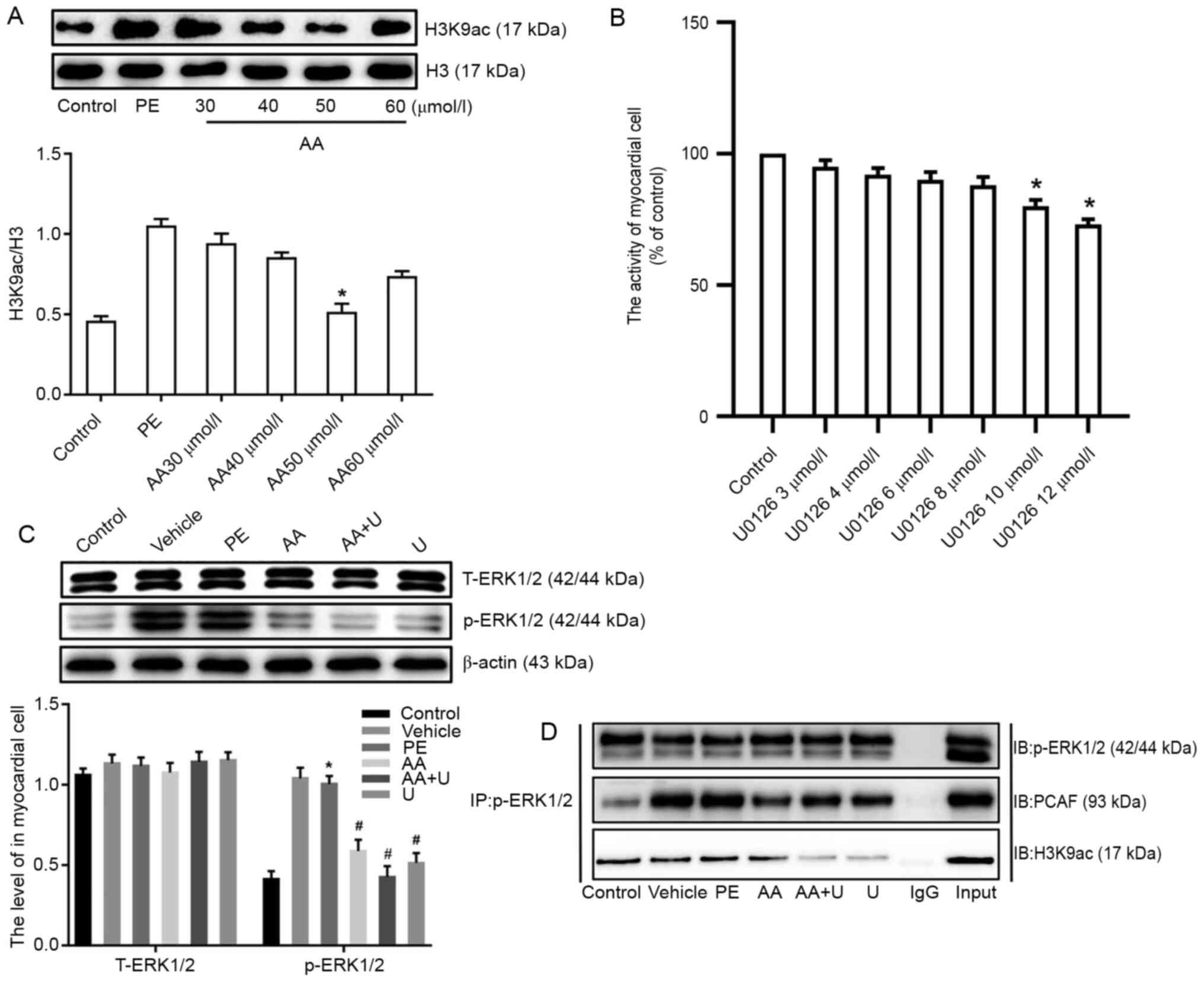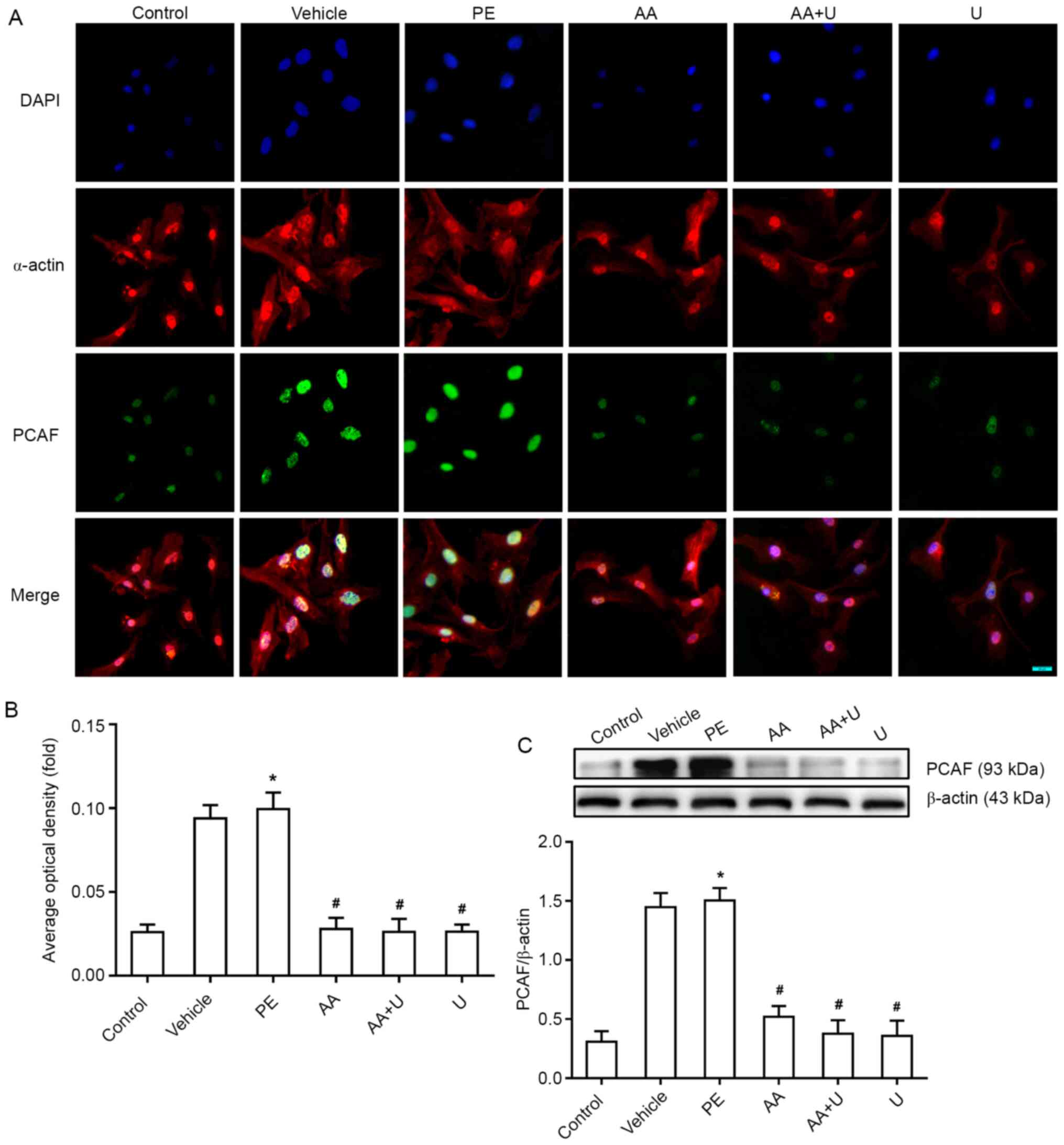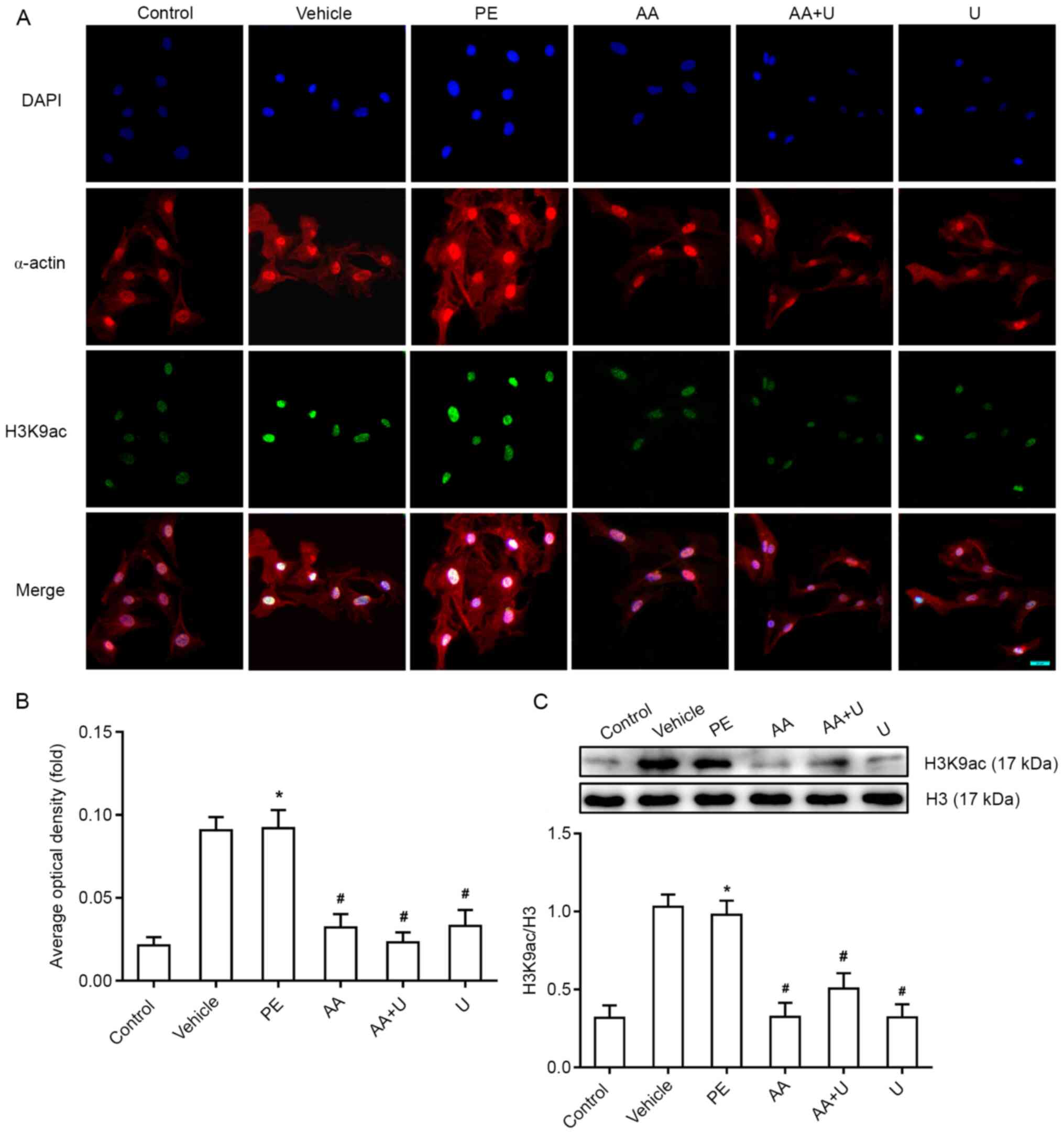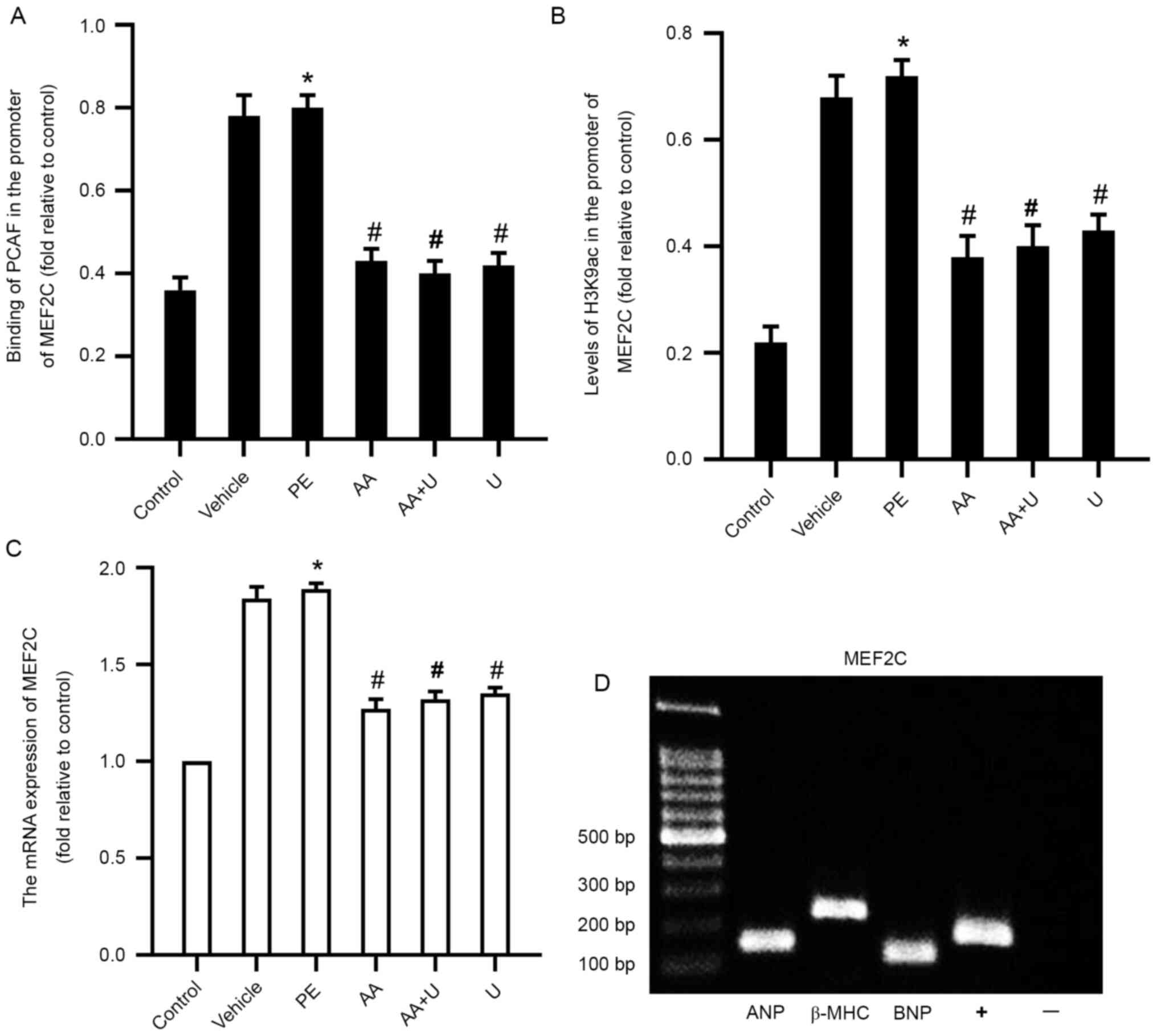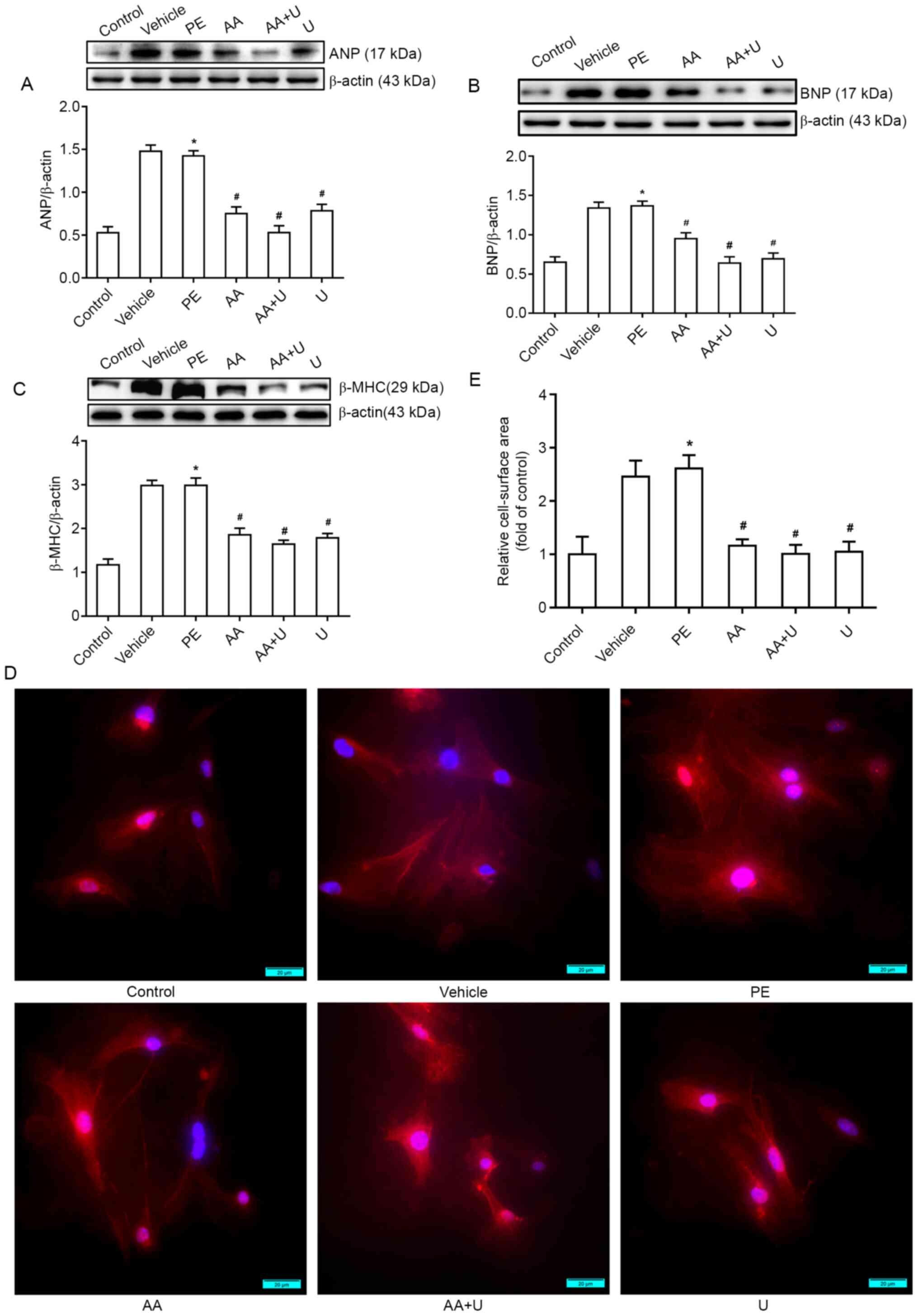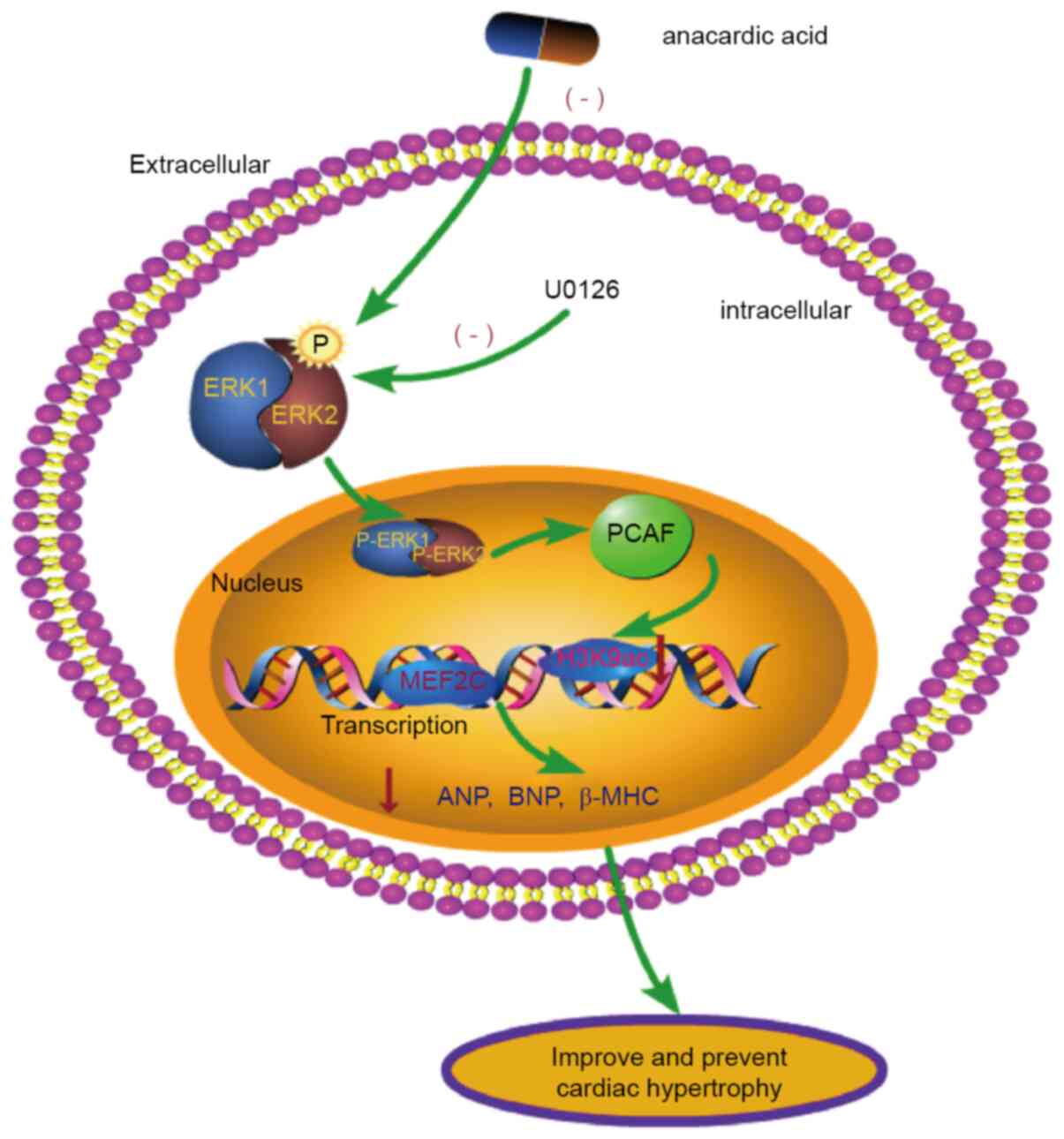|
1
|
Degoricija V, Trbušić M, Potočnjak I,
Radulović B, Terešak SD, Pregartner G, Berghold A, Tiran B and
Frank S: Acute heart failure developed as worsening of chronic
heart failure is associated with increased mortality compared to de
novo cases. Sci Rep. 8:95872018. View Article : Google Scholar : PubMed/NCBI
|
|
2
|
Yu B, Zhao Y, Zhang H, Xie D, Nie W and
Shi K: Inhibition of microRNA-143-3p attenuates myocardial
hypertrophy by inhibiting inflammatory response. Cell Biol Int.
42:1584–1593. 2018. View Article : Google Scholar : PubMed/NCBI
|
|
3
|
Wehbe N, Nasser SA, Pintus G, Badran A,
Eid AH and Baydoun E: MicroRNAs in cardiac hypertrophy. Int J Mol
Sci. 20:47142019. View Article : Google Scholar : PubMed/NCBI
|
|
4
|
Peng C, Luo X, Li S and Sun H:
Phenylephrine-induced cardiac hypertrophy is attenuated by a
histone acetylase inhibitor anacardic acid in mice. Mol Biosyst.
13:714–724. 2017. View Article : Google Scholar : PubMed/NCBI
|
|
5
|
Gao W, Guo N, Zhao S, Chen Z, Zhang W, Yan
F, Liao H and Chi K: Carboxypeptidase A4 promotes cardiomyocyte
hypertrophy through activating PI3K-AKT-mTOR signaling. Biosci Rep.
40:BSR202006692020. View Article : Google Scholar : PubMed/NCBI
|
|
6
|
Gai Z, Wang Y, Tian L, Gong G and Zhao J:
Whole genome level analysis of the Wnt and DIX gene families in
mice and their coordination relationship in regulating cardiac
hypertrophy. Front Genet. 12:6089362021. View Article : Google Scholar : PubMed/NCBI
|
|
7
|
Siti HN, Jalil J, Asmadi AY and Kamisah Y:
Rutin modulates MAPK pathway differently from Quercetin in
angiotensin II–Induced H9c2 cardiomyocyte hypertrophy. Int J Mol
Sci. 22:50632021. View Article : Google Scholar : PubMed/NCBI
|
|
8
|
Bogdanova E, Beresneva O, Galkina O,
Zubina I, Ivanova G, Parastaeva M, Semenova N and Dobronravov V:
Myocardial hypertrophy and fibrosis are associated with
cardiomyocyte Beta-Catenin and TRPC6/Calcineurin/NFAT signaling in
spontaneously hypertensive rats with 5/6 Nephrectomy. Int J Mol
Sci. 22:46452021. View Article : Google Scholar : PubMed/NCBI
|
|
9
|
Tamura S, Marunouchi T and Tanonaka K:
Heat-shock protein 90 modulates cardiac ventricular hypertrophy via
activation of MAPK pathway. J Mol Cell Cardiol. 127:134–142. 2019.
View Article : Google Scholar : PubMed/NCBI
|
|
10
|
Hu B, Song JT, Ji XF, Liu ZQ, Cong ML and
Liu DX: Sodium Ferulate protects against angiotensin II–Induced
cardiac hypertrophy in mice by regulating the MAPK/ERK and JNK
Pathways. Biomed Res Int. 2017:37549422017. View Article : Google Scholar : PubMed/NCBI
|
|
11
|
Yan ZP, Li JT, Zeng N and Ni GX: Role of
extracellular signal-regulated kinase 1/2 signaling underlying
cardiac hypertrophy. Cardiol J. 28:473–482. 2021. View Article : Google Scholar : PubMed/NCBI
|
|
12
|
Gu J, Hu W, Song ZP, Chen YG, Zhang DD and
Wang CQ: Rapamycin inhibits cardiac hypertrophy by promoting
autophagy via the MEK/ERK/Beclin-1 pathway. Front Physiol.
7:1042016. View Article : Google Scholar : PubMed/NCBI
|
|
13
|
Huang Y, Wu L, Wu J, Li Y and Hou L:
Cellular FLICE-like inhibitory protein protects against cardiac
hypertrophy by blocking ASK1/p38signaling in mice. Mol Cell
Biochem. 397:87–95. 2014. View Article : Google Scholar : PubMed/NCBI
|
|
14
|
Zhou J, Gao J, Zhang X, Liu Y, Gu S, Zhang
X, An X, Yan J, Xin Y and Su P: MicroRNA-340-5p functions
downstream of cardiotrophin-1 to regulate cardiac eccentric
hypertrophy and heart failure via target gene dystrophin. Int Heart
J. 56:454–458. 2015. View Article : Google Scholar : PubMed/NCBI
|
|
15
|
Li B, Wang X, Yu M, Yang P and Wang W:
G6PD, bond by miR-24, regulates mitochondrial dysfunction and
oxidative stress in phenylephrine-induced hypertrophic
cardiomyocytes. Life Sci. 260:1183782020. View Article : Google Scholar : PubMed/NCBI
|
|
16
|
Melchert RB, Liu H, Granberry MC and
Kennedy RH: Lovastatin inhibits phenylephrine-induced ERK
activation and growth of cardiac. Cardiovasc Toxicol. 1:237–252.
2001. View Article : Google Scholar : PubMed/NCBI
|
|
17
|
Zhong L, Chiusa M, Cadar AG, Lin A,
Samaras S, Davidson JM and Lim CC: Targeted inhibition of ANKRD1
disrupts sarcomeric ERK-GATA4 signal transduction and abrogates
phenylephrine-induced cardiomyocyte hypertrophy. Cardiovasc Res.
106:261–271. 2015. View Article : Google Scholar : PubMed/NCBI
|
|
18
|
Schreckenberg R, Taimor G, Piper HM and
Schlüter KD: Inhibition of Ca2+-dependent PKC isoforms unmasks
ERK-dependent hypertrophic growth evoked by phenylephrine in adult
ventricular cardiomyocytes. Cardiovasc Res. 63:553–560. 2004.
View Article : Google Scholar : PubMed/NCBI
|
|
19
|
EUR-Lex, . Directive 2010/63/EU of the
European Parliament and of the Council of 22 September 2010 on the
protection of animals used for scientific purposes. Official J
European Union. 53:L 276/33–L 276/79. 2010.
|
|
20
|
Peng BH, Peng C, Huang LX, Luo XM and Han
X: The roles of P38 MAPK in the process of anacardic acid
attenuating mouse cardiomyocyte hypertrophy induced by
phenylephrine. Chin J Pathophys. 36:200–205. 2020.PubMed/NCBI
|
|
21
|
Yin Y, Guan Y, Duan J, Wei G, Zhu Y, Quan
W, Guo C, Zhou D, Wang Y, Xi M and Wen A: Cardioprotective effect
of Danshensu against myocardial ischemia/reperfusion injury and
inhibits apoptosis of H9c2 cardiomyocytes via Akt and ERK1/2
phosphorylation. Eur J Pharmacol. 699:219–226. 2013. View Article : Google Scholar : PubMed/NCBI
|
|
22
|
Zhao Q, Zhang X, Cai H, Zhang P, Kong D,
Ge X, Du M, Liang R and Dong W: Anticancer effects of plant derived
anacardic acid on human breast cancer MDA-MB-231 cells. Am J Transl
Res. 10:2424–2434. 2018.PubMed/NCBI
|
|
23
|
Li Q, Li ZM, Sun SY, Wang LP, Wang PX, Guo
Z, Yang HW, Ye JT, Lu J and Liu PQ: PARP1 interacts with HMGB1 and
promotes its nuclear export in pathological myocardial hypertrophy.
Acta Pharmacol Sin. 40:589–598. 2019. View Article : Google Scholar : PubMed/NCBI
|
|
24
|
Frias MA, Rebsamen MC, Gerber-Wicht C and
Lang U: Prostaglandin E2 activates Stat3 in neonatal rat
ventricular cardiomyocytes: A role in cardiac hypertrophy.
Cardiovasc Res. 73:57–65. 2007. View Article : Google Scholar : PubMed/NCBI
|
|
25
|
Livak KJ and Schmittgen TD: Analysis of
relative gene expression data using real-time quantitative PCR and
the 2(-Delta Delta C(T)) method. Methods. 25:402–408. 2001.
View Article : Google Scholar : PubMed/NCBI
|
|
26
|
Peng B, Han X, Peng C, Luo X, Deng L and
Huang L: G9α-dependent histone H3K9me3 hypomethylation promotes
overexpression of cardiomyogenesis-related genes in foetal mice. J
Cell Mol Med. 24:1036–1045. 2020. View Article : Google Scholar : PubMed/NCBI
|
|
27
|
Ren J, Zhang N, Liao H, Chen S, Xu L, Li
J, Yang Z, Deng W and Tang Q: Caffeic acid phenethyl ester
attenuates pathological cardiac hypertrophy by regulation of
MEK/ERK signaling pathway in vivo and vitro. Life Sci. 181:53–61.
2017. View Article : Google Scholar : PubMed/NCBI
|
|
28
|
Saleem N, Prasad A and Goswami SK:
Apocynin prevents isoproterenol-induced cardiac hypertrophy in rat.
Mol Cell Biochem. 445:79–88. 2018. View Article : Google Scholar : PubMed/NCBI
|
|
29
|
Önal B, Özen D, Demir B, Gezen Ak D,
Dursun E, Demir C, Akkan AG and Özyazgan S: The anti-inflammatory
effects of Anacardic acid on a TNF-α-Induced human saphenous vein
endothelial cell culture model. Curr Pharm Biotechnol. 21:710–719.
2020. View Article : Google Scholar
|
|
30
|
Lee MJ, Tsai YJ, Lin MY, You HL, Kalyanam
N, Ho CT and Pan MH: Calebin-A induced death of malignant
peripheral nerve sheath tumor cells by activation of histone
acetyltransferase. Phytomedicine. 57:377–384. 2019. View Article : Google Scholar : PubMed/NCBI
|
|
31
|
Li S, Peng B, Luo X, Sun H and Peng C:
Anacardic acid attenuates pressure-overload cardiac hypertrophy
through inhibiting histone acetylases. J Cell Mol Med.
23:2744–2752. 2019. View Article : Google Scholar : PubMed/NCBI
|
|
32
|
Luo XM, Che JL, Liu SR, Long S, Zhao PX,
Xu P, Wei Y and Peng C: The effects of histone acetylation
modification on cardiac hypertrophy induced by two different
modeling methods in mice. J Clin Cardiol. 33:1106–1110. 2017.
|
|
33
|
Zhang G and Ni X: Knockdown of TUG1
rescues cardiomyocyte hypertrophy through targeting the
miR-497/MEF2C axis. Open Life Sci. 16:242–251. 2021. View Article : Google Scholar : PubMed/NCBI
|
|
34
|
Khajehlandi M, Bolboli L, Siahkuhian M,
Rami M, Tabandeh M, Khoramipour K and Suzuki K: Endurance training
regulates expression of some angiogenesis-related genes in cardiac
tissue of experimentally induced diabetic rats. Biomolecules.
11:4982021. View Article : Google Scholar : PubMed/NCBI
|
|
35
|
Wang HN, Li JL, Xu T, Yao HQ, Chen GH and
Hu J: Effects of Sirt3 autophagy and resveratrol activation on
myocardial hypertrophy and energy metabolism. Mol Med Rep.
22:1342–1350. 2020. View Article : Google Scholar : PubMed/NCBI
|
|
36
|
Ding J, Liu S, Qian W, Wang J, Chu C, Wang
J, Li K, Yu Y, Xu G, Mao Z, et al: Swietenine extracted from
Swietenia relieves myocardial hypertrophy induced by isoprenaline
in mice. Environ Toxicol. 35:1343–1351. 2020. View Article : Google Scholar : PubMed/NCBI
|
|
37
|
Zhang LX, Du J, Zhao YT, Wang J, Zhang S,
Dubielecka PM, Wei L, Zhuang S, Qin G, Chin YE and Zhao TC:
Transgenic overexpression of active HDAC4 in the heart attenuates
cardiac function and exacerbates remodeling in infarcted
myocardium. J Appl Physiol. 125:1968–1978. 2018. View Article : Google Scholar : PubMed/NCBI
|
|
38
|
Stenzig J, Schneeberger Y, Löser A, Peters
BS, Schaefer A, Zhao RR, Ng SL, Höppner G, Geertz B, Hirt MN, et
al: Pharmacological inhibition of DNA methylation attenuates
pressure overload-induced cardiac hypertrophy in rats. J Mol Cell
Cardiol. 120:53–63. 2018. View Article : Google Scholar : PubMed/NCBI
|
|
39
|
Lin L, Xu W, Li Y, Zhu P, Yuan W, Liu M,
Shi Y, Chen Y, Liang J, Chen J, et al: Pygo1 regulates pathological
cardiac hypertrophy via a β-catenin-dependent mechanism. Am J
Physiol Heart Circ Physiol. 320:H1634–H1645. 2021. View Article : Google Scholar : PubMed/NCBI
|
|
40
|
Kuwabara Y, Horie T, Baba O, Watanabe S,
Nishiga M, Usami S, Izuhara M, Nakao T, Nishino T, Otsu K, et al:
MicroRNA-451 exacerbates lipotoxicity in cardiac myocytes and
high-fat diet-induced cardiac hypertrophy in mice through
suppression of the LKB1/AMPK pathway. Circ Res. 116:279–288. 2015.
View Article : Google Scholar : PubMed/NCBI
|
|
41
|
Gallo S, Vitacolonna A, Bonzano A,
Comoglio P and Crepaldi T: ERK: A key player in the pathophysiology
of cardiac hypertrophy. Int J Mol Sci. 20:21642019. View Article : Google Scholar : PubMed/NCBI
|
|
42
|
Breitenbach T, Lorenz K and Dandekar T:
How to steer and control ERK and the ERK signaling cascade
exemplified by looking at cardiac insufficiency. Int J Mol Sci.
20:21792019. View Article : Google Scholar : PubMed/NCBI
|
|
43
|
Liu R and Molkentin JD: Regulation of
cardiac hypertrophy and remodeling through the dual-specificity
MAPK phosphatases (DUSPs). J Mol Cell Cardio. 101:44–49. 2016.
View Article : Google Scholar : PubMed/NCBI
|
|
44
|
Zhang Y, Cui Y, Dai S, Deng W, Wang H, Qin
W, Yang H, Liu H, Yue J, Wu D, et al: Isorhynchophylline enhances
Nrf2 and inhibits MAPK pathway in cardiac hypertrophy. Naunyn
Schmiedebergs Arch Pharmacol. 393:203–212. 2020. View Article : Google Scholar : PubMed/NCBI
|
|
45
|
Peng BH: Role of JNK/MAPK
signaling-dependent regulation of histone acetylation on the
attenuation of anacardic acid for cardiomyocyte hypertrophy induced
by phenylephrine (unpublished PhD thesis). Zunyi Medical
University; 2020
|
|
46
|
Ba L, Gao J, Chen Y, Qi H, Dong C, Pan H,
Zhang Q, Shi P, Song C, Guan X, et al: Allicin attenuates
pathological cardiac hypertrophy by inhibiting autophagy via
activation of PI3K/Akt/mTOR and MAPK/ERK/mTOR signaling pathways.
Phytomedicine. 58:1527652019. View Article : Google Scholar : PubMed/NCBI
|
|
47
|
Kim MJ, Im MA, Lee JS, Mun JY, Kim DH, Gu
A and Kim IS: Effect of S100A8 and S100A9 on expressions of
cytokine and skin barrier protein in human keratinocytes. Mol Med
Rep. 20:2476–2483. 2019.PubMed/NCBI
|
|
48
|
Sun Y, Liu WZ, Liu T, Feng X, Yang N and
Zhou HF: Signaling pathway of MAPK/ERK in cell proliferation,
differentiation, migration, senescence and apoptosis. J Recept
Signal Transduct Res. 35:600–604. 2015. View Article : Google Scholar : PubMed/NCBI
|
|
49
|
Gentile MT, Russo R, Pastorino O, Cioffi
S, Barbieri F, Illingworth EA, Grieco M, Chambery A and
Colucci-D'Amato L: Ruta graveolens water extract inhibits cell-cell
network formation in human umbilical endothelial cells via
MEK-ERK1/2 pathway. Exp Cell Res. 64:50–58. 2018. View Article : Google Scholar : PubMed/NCBI
|
|
50
|
Dai X, Song R and Xiong Y: The expression
of ERK and JNK in patients with an endemic osteochondropathy,
Kashin-Beck disease. Exp Cell Res. 359:337–341. 2017. View Article : Google Scholar : PubMed/NCBI
|
|
51
|
Cipolletta E, Rusciano MR, Maione AS,
Santulli G, Sorriento D, Del Giudice C, Ciccarelli M, Franco A,
Crola C, Campiglia P, et al: Targeting the CaMKII/ERK interaction
in the heart prevents cardiac hypertrophy. PLoS One.
10:e01304772015. View Article : Google Scholar : PubMed/NCBI
|
|
52
|
Wang Y, Guo Z, Gao Y, Liang P, Shan Y and
He J: Angiotensin II receptor blocker LCZ696 attenuates cardiac
remodeling through the inhibition of the ERK signaling pathway in
mice with pregnancy-associated cardiomyopathy. Cell Biosci.
9:862019. View Article : Google Scholar : PubMed/NCBI
|
|
53
|
Thienpont B, Aronsen JM, Robinson EL,
Okkenhaug H, Loche E, Ferrini A, Brien P, Alkass K, Tomasso A,
Agrawal A, et al: The H3K9 dimethyltransferases EHMT1/2 protect
against pathological cardiac hypertrophy. J Clin Invest.
127:335–348. 2017. View Article : Google Scholar : PubMed/NCBI
|
|
54
|
Xing S, Tian JZ, Yang SH, Huang XT, Ding
YF, Lu QY, Yang JS and Yang WJ: Setd4 controlled quiescent
c-Kit+ cells contribute to cardiac neovascularization of
capillaries beyond activation. Sci Rep. 11:116032021. View Article : Google Scholar : PubMed/NCBI
|
|
55
|
Wei J, Joshi S, Speransky S, Crowley C,
Jayathilaka N, Lei X, Wu Y, Gai D, Jain S, Hoosien M, et al:
Reversal of pathological cardiac hypertrophy via the
MEF2-coregulator interface. JCI Insight. 2:e910682017. View Article : Google Scholar : PubMed/NCBI
|
|
56
|
Marmorstein R and Zhou MM: Writers and
readers of histone acetylation: Structure, mechanism, and
inhibition. Cold Spring Harb Perspect Biol. 6:a0187622014.
View Article : Google Scholar : PubMed/NCBI
|
|
57
|
Gao W, Pan B, Liu L, Huang X, Liu Z and
Tian J: Alcohol exposure increases the expression of cardiac
transcription factors through ERK1/2-mediated histone3
hyperacetylation in H9c2 cells. Biochem Biophys Res Commun.
466:670–675. 2015. View Article : Google Scholar : PubMed/NCBI
|
|
58
|
Ferguson BS, Harrison BC, Jeong MY, Reid
BG, Wempe MF, Wagner FF, Holson EB and McKinsey TA:
Signal-dependent repression of DUSP5 by class I HDACs controls
nuclear ERK activity and cardiomyocyte hypertrophy. Proc Natl Acad
Sci USA. 110:9806–9811. 2013. View Article : Google Scholar : PubMed/NCBI
|
|
59
|
Lambert M, Jambon S, Depauw S and
David-Cordonnier MH: Targeting transcription factors for cancer
treatment. Molecules. 23:14792018. View Article : Google Scholar : PubMed/NCBI
|
|
60
|
Peng C, Zhang W, Zhao W, Zhu J, Huang X
and Tian J: Alcohol-induced histone H3K9 hyperacetylation and
cardiac hypertrophy are reversed by a histone acetylases inhibitor
anacardic acid in developing murine hearts. Biochimie. 113:1–9.
2015. View Article : Google Scholar : PubMed/NCBI
|
|
61
|
Peng C, Zhu J, Sun HC, Huang XP, Zhao WA,
Zheng M, Liu LJ and Tian J: Inhibition of histone H3K9 acetylation
by anacardic acid can correct the over-expression of Gata4 in the
hearts of fetal mice exposed to alcohol during pregnancy. PLoS One.
9:e1041352014. View Article : Google Scholar : PubMed/NCBI
|
|
62
|
Cardoso AC, Pereira AHM, Ambrosio ALB,
Consonni SR, Rocha de Oliveira R, Bajgelman MC, Dias SMG and
Franchini KG: FAK forms a complex with MEF2 to couple biomechanical
signaling to transcription in cardiomyocytes. Structure.
24:1301–1310. 2016. View Article : Google Scholar : PubMed/NCBI
|















